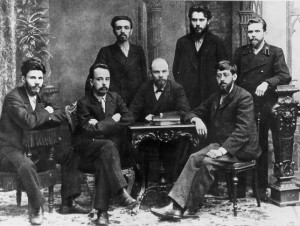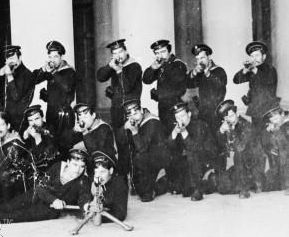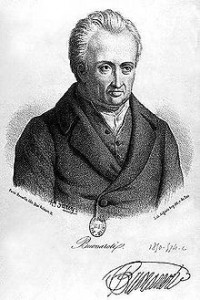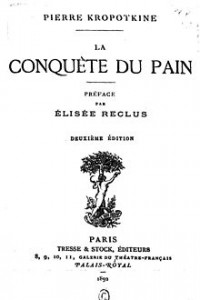The issue of revolution looms large in the minds of socialists.
The bewildering array of radical groups, most of whom proclaim their allegiance to revolution as the central feature which defines their existence as radicals, gives the impression of them all being fellow travellers on a common journey.
But what is meant by revolution? Do the Sparticists want the same thing as the syndicalists? Does the Socialist Workers Party want the same thing as Syriza?
If we examined the fine detail of each group’s doctrines of revolution, we would likely find that there are almost as many interpretations of revolution as there are groups. So, in a bid to illuminate the fundamental differences between the various conceptions, we are going to dispense with the more nuanced shades that are also a factor in perpetuating the existence of so many radical socialist parties.
In this article we will outline three basic types of revolution, which although not mutually exclusive, do carry their own logic in terms of informing their adherents of their strategic orientation. Before we plunge in, however, we should say that we won’t be addressing that favourite of Anarchist vs Marxist debates: direct democracy vs party rule.
The three types of revolution are: insurrection against the capitalist state, socialistion of production, and communisation of consumption. Note that a group may support any one, two, or three of the above and call itself revolutionary. Let’s first take insurrection against the capitalist state.
The Rupture
The addition of qualifier “against the capitalist state” when discussing insurrection is important because it refers to one of the great schisms in the socialist movement, that which is personified by the split between Lenin and Kautsky. For the latter, the revolutions of 1918 essentially dealt with the issue of insurrection against the undemocratic regimes. The issue is slightly complicated by the interlude of fascism, a virulent and highly destructive episode to be sure, but not one, in the advanced capitalist states at least, that has had much by the way of longevity.
For Lenin, and those following in his footsteps, the revolutions of 1918 were a failure and have yet to be completed. Revolutionary Anarchists also populate this camp and the differences between them and Leninists is a difference that is mostly internal to this type of revolution. As neither Leninists nor Anarchists like to be identified as belonging to the other’s camp, we designate them as insurrectionists. To say that they are insurrectionists is not to say that they are storing guns in bunkers and plotting a coup d’etat. For the most part insurrectionists think in mass terms, of, for example, a prolonged series of street insurrections of the type that brought down the eastern bloc or, for any youngsters reading this, of Cairo in 2011.
Such an insurrection, if followed through to its end, as in 1917, and not headed off, as in, say, the revolutions of 1848, eliminates the coercive force that prevents the working class from freeing itself from its subordinate role. And, in a mirror image at the opposite end of society, the smashing of the capitalist state leaves the capitalists unable to defend themselves.
That doesn’t mean that it’ll be plain sailing after breaking up the old state apparatus. All insurrectionaries accept that the capitalists will reorganise and fight back but they expect it to free up, to an enormous extent, the possibilities for future action. The central point, then, is that in order to progress towards socialism the coercive force that prevents progress being made on other fronts must be dealt with.
The Socialisers
Lenin’s primary opponents within the socialist movement, the Marxist Centre (roughly referring to Kautsky, Adler, Bauer, Martov etc and the later Eurocommunist parties, though they would likely deny the similarity to the renegade), accepts the legitimacy of the current state. They may have criticisms — even a lot of criticisms — of its democratic shortcomings, e.g. the continuing power of an unaccountable security apparatus, but they are not proposing an insurrection with the explicit aim of smashing it. They advocate democraticisation through reform.
Therefore, while some elements of that lineage may call for a civic revolution and accept a modicum of civil disobedience, it’s more a rhetorical device and quite a different conception to that of the insurrectionary rupture as proposed by Leninists and Anarchists. Their revolution is more akin to that of the industrial revolution or the women’s revolution of the 20th century. Such revolutions brought extremely deep and far reaching change but they are of different kind to the sharp blows of the French and Russian revolutions.
The second axes of revolution they support is the socialization of production. This is likely to prove a little more controversial since most — but not all — socialists are for the socialisation of production; it’s generally considered a defining feature of being a socialist. But we want to look at it in relation to other meanings of revolution — insurrection and communisation — and its place in a hierarchy of strategic options rather than as a moral proposition which one is for or against. We use the word hierarchy here to indicate that a focus on one type of revolutionary activity tends to lower the role of the others, though it does not, of course, exclude it.
The insurrectionists usually consider socialisation of production on a significant scale to be impossible before the capitalist state is smashed. It is, after all, why they want to smash it. The aim of the socialisation of production is to promote alternative social relations to the capitalist ones of employer and wage-labourer and best exemplified by worker co-operatives.
The Marxist centrists propose building up institutions capable of sustaining co-operative relations so that when state power is achieved — legally! — a more or less rapid process of socialization of production will ensue. In his later work, Kautsky called this the social revolution and he distinguished it from the political revolution which he viewed as more or less accomplished.
There are two aspects to this, the before and after of achieving state power. Unlike the insurrectionaries, the Centrists aim to build up mass institutions (co-operatives, a mass party capable of securing a parliamentary majority etc) which make the process of socialisation much easier once governmental power is achieved. Where the insurrectionaries aim to put a wrench in the wheel of the reproduction of capitalist social relations by disrupting the state’s role in it, the centrists aim to do so by creating institutions which not only practice co-operative social relations but which, in doing so, demonstrate their economic superiority to institutions organised on capitalist lines.
The more surplus their socialised insitutions can garner, the more they can grow and form a mutually supporting movement, e.g. profitable co-ops subsidize a mass media which in turn helps the party gain a majority. As the workers’ organisations gain political and economic power, decisions regarding investment, e.g., whether to build a nuclear power station or a nuclear bomb, to build a railways or a motorway, become democratised.
Capital allocation is no longer a private decision made by capitalists but a public one made by democratic choice. Capitalism, therefore, is no longer the dominant economic mode of production.
Socialisation is important for insurrectionaries too, but it must wait until part one has been completed. Until that point, the state will prevent the workers’ institutions attaining the power they need to effect a social transformation. Once the state has been smashed, production will be progressively socialised both in order to take steps towards socialism and to ensure that a capitalist class does not reconstitute itself.
Generally, insurrectionaries are a bit vague on this front, viewing too much detail as veering close to prescribing blueprints for an unknowable future. Often they simply say that the socialisation process will be one that emerges organically from the masses transformed by the revolutionary process itself.
The Communisers
There is a third kind of revolution amongst the revolutionary left: the communisation of consumption. Marx, in his ‘Critique of the Gotha Programme’ mentions lower and higher phases of communism. The lower phase is roughly what we have described above as the socialisation of production.
Under a socialised economy, ownership is held in common and investment is democratically directed, but consumption is not organised in the same fashion. One’s entitlement to consume the social product may still be tied to how much worth one’s labour is deemed to have, e.g. a longer work day could entitle you to a higher income.
For some revolutionaries, such a state of affairs does not constitute a real revolutionary overturn of capitalism at all. Production is still conducted with an eye of accumulation, even if no longer privately controlled. A return to fully fledged capitalism, as occurred when the Soviet Union collapsed, is, in their view, an inevitable consequence of not starting the revolution from this third, indispensable point: an equal entitlement for all in the share of the social product.
Many insurrectionaries and centrists support communism of consumption as a longterm goal but do not see it as something to be implemented straight away or, in the case of the insurrectionaries, in the immediate aftermath of a successful destruction of state power.
And it might seem that the socialisation of production would facilitate the growth of communisation. However, the proponents of the communisation tend to be extremely skeptical that this will occur and instead view a thorough communisation process as the only way to prevent the re-emergence of capitalism.
One of the most eloquent advocates of a specifically communist revolution was Kropotkin. For him, the socialisation of production in itself was a variation on the wages-system of capitalism and it would naturally lead to the recreation of class society.
A modern articulation of this view emerges more from the journal Endnotes: [Communisation]…a movement characterised by immediate communist measures (such as the free distribution of goods) both for their own merit, and as a way of destroying the material basis of the counter-revolution. If, after a revolution, the bourgeoisie is expropriated but workers remain workers, producing in separate enterprises, dependent on their relation to that workplace for their subsistence, and exchanging with other enterprises… the capitalist content remains, and sooner or later the distinct role or function of the capitalist will reassert itself. By contrast, the revolution as a communising movement would destroy – by ceasing to constitute and reproduce them – all capitalist categories: exchange, money, commodities, the existence of separate enterprises, the State and – most fundamentally – wage labour and the working class itself.
Similarly, Kropotkin supported the freedom of all to choose their levels of consumption without reference to what they had contributed to society, irrespective of who directed investment or who owned the means of production.
For Kropotkin, and in sharp contrast to his contemporary Karl Kautsky, consumption was the basis of political economy since it, in his view, determined how production was to be conducted. For orthodox Marxists like Kautsky, production was the key element which determined what was possible in terms of consumption and, indeed, much else in human society.
Neither the Anarcho-Communists nor the modern Communisers support the socialisation of production as an end. If anything, the severity of their criticism of those who do support it as a key waypoint indicates that they think that way of conceptualising the route to socialism as inherently counter-productive, if not outright counter-revolutionary.At the other end of the communisation pole, but outside the scope of this essay, lie the lifestylist communisers, e.g. hippies who eschew politics more or less altogether.
It is not the point of this essay to pronounce one way or the other, although as readers of this site will have realised, our sympathies lie with the Marxist Centre. We would, however, like to finish by drawing attention to how these categories of insurrectionary, socialisation, and communisation cut across the traditional way of group radical leftists into Anarchist, Leninist, and Marxist. Apart from their respective views of the role of the state and, therefore, the party, a significant line divides the pre-World War Anarchists and Marxists over the question of immediate adoption of communisation measures. But the traditional division of Marxism / Anarchism doesn’t always capture the views of their nominal adherents, especially as the years drift by. Take Anarchism for example.
- Proudhon: anti-insurrectionary against all states, pro-socialisation of production and anti-communisation.
- Bakunin: pro-insurrectionary, pro-socialisation, and anti-communisation.
- Kropotkin: pro-insurrectionary, anti-socialisation, and pro-communisation.
On the Marxist side, we have:
- Kautsky: pro-insurrectionary against the feudal states but anti-insurrectionary against the bourgeois democracies, pro-socialisation of production, and anti-communisation.
- Lenin: insurrectionary against all states, including bourgeois democracy, pro-socialisation and anti-communisation
- Gilles Dauve: insurrectionary, anti-socialisation and pro-communisation.
This isn’t to argue that, say, Proudhon was identical to the post-1918 Kautsky; their perception of the utility of the state was quite different. But it does indicate that they were somewhat closer than is often thought. Certainly, Bakunin and Lenin shared fundamental similarities, as Kautsky and the left Mensheviks never tired of pointing out in a mixture of horror and glee.
And for all the invective directed by Lenin against Kautsky after 1914, he shared, with the possible exception of the euphoric years of 1917 and 1918, Kautsky’s views on the necessity to make advances on the socialisation of production before new vistas of social progress could be considered.

















4 Responses to Three types of revolution